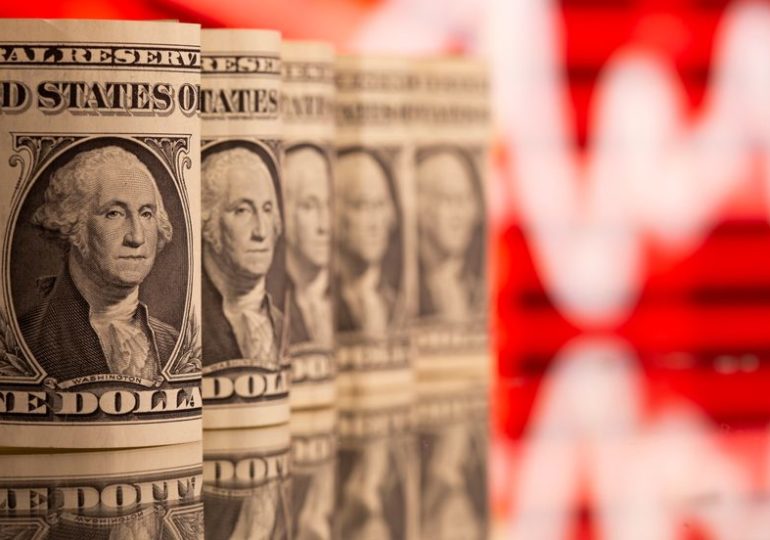 © Reuters. U.S. One dollar banknotes are seen in front of displayed stock graph in this illustration taken
© Reuters. U.S. One dollar banknotes are seen in front of displayed stock graph in this illustration taken
By Kevin Buckland
TOKYO (Reuters) – The dollar hit a fresh four-month high against the euro on Thursday as the U.S. pandemic response continued to outpace Europe's, which has been hobbled by extended lockdowns and delayed vaccine rollouts.
The safe-haven greenback held on to most of a broad two-day advance, which has been fuelled by worries ranging from Europe's third COVID-19 wave and potential U.S. tax hikes to the persistent spectre of inflation.
Even Germany's reversal of a call for a strict lockdown over the Easter period did little to build confidence in the region's economic outlook, instead compounding discontent with Chancellor Angela Merkel's handling of the pandemic.
"The weak point in Europe remains around the vaccine rollout amid the rise in new virus cases and the tightening of restrictions … which likely means the mooted acceleration in Q2 may have to be pushed back by a quarter," Tapas Strickland, director of economics and markets at National Australian Bank, wrote in a client note.
"The narrative of the U.S. outperforming Europe in the coming quarter remains."
The euro traded near the four-month low of $1.1809 touched earlier in the Asian session, while a gauge of the dollar against six major peers hovered just below a four-month high of 92.617 reached overnight.
The dollar gained 0.2% to 108.905 yen, another safe-haven currency, as the pair continued to consolidate below 109.
At the same time, the dollar's rally showed some signs of fatigue, as some of its bruised rivals recovered from lows amid gains in many Asian equity markets.
Australia's dollar, considered a liquid proxy for risk appetite, bounced 0.3% after earlier dipping to $0.7579, the lowest level since Feb. 2.
The British pound rose 0.2%, climbing out of a six-week trough at $1.3675.
Meanwhile, benchmark 10-year Treasury yields consolidated around 1.6%, a week after hitting a more than one-year top of 1.754%, which had also supported the dollar.
"The U.S. longer-term Treasury yield is lower than the previous week’s level, and that is a very big factor for the improvement in market sentiment," said Minori Uchida, chief currency analyst at MUFG Bank.
"Even if the yield is 1.6 or 1.7%, it is not enough to push up the dollar constantly."
On Wednesday, U.S. Treasury Secretary Janet Yellen and Federal Reserve Chair Jerome Powell expressed their confidence in the U.S. recovery during a second day of testimony to Congress.
Yellen told Senate lawmakers she was open to banks buying back stock and paying dividends, an updated view showing her confidence in the economy. Powell also said he thinks 2021 will be a "very, very strong year in the most likely case."
A day earlier, though, the treasury secretary had put investors on alert after espousing tax hikes to pay for President Joe Biden's plans for upgrading infrastructure and other investments.
Inflation could also rear its head as disruptions in the supply chain exert cost pressures for manufacturers, with U.S. factory activity picking up in early March.
Meanwhile in Europe, an unexpected expansion of business activity did little to brighten the mood, with renewed COVID-19 lockdowns in many of the bloc's member nations meaning the gains may not last through April.
Concerns have been magnified because the third wave of infections is being largely driven by the U.K. strain of the virus, according to Commonwealth Bank of Australia (OTC:CMWAY) strategist Kim Mundy.
"The risk is that the more contagious and deadly strain of the virus elicits a stronger response from European governments, which sees Europe remaining locked down for longer," she wrote in a note.
"A significant delay to Europe's re‑opening efforts will only widen the divergence between the economic outlook in Europe and the U.S.," putting additional pressure on the euro, she said.
In cryptocurrencies, bitcoin continued to swing widely, falling below $52,000 again in early Asian trading before recovering to around $52,123.
That is after briefly topping $57,000 overnight after Tesla (NASDAQ:TSLA) Inc boss Elon Musk said customers can now buy the company's electric cars with the digital token.
Bitcoin hit a record high of $61,781.83 on March 13.
========================================================
Currency bid prices at 400 GMT
Description RIC Last U.S. Close Pct Change YTD Pct High Bid Low Bid
Previous Change
Session
Euro/Dollar
$1.1823 $1.1815 +0.07% -3.23% +1.1828 +1.1804
Dollar/Yen
108.8850 108.6800 +0.21% +5.44% +108.9770 +108.7500
Euro/Yen
128.74 128.42 +0.25% +1.43% +128.8300 +128.4300
Dollar/Swiss
0.9354 0.9358 -0.06% +5.71% +0.9365 +0.9352
Sterling/Dollar
1.3699 1.3680 +0.17% +0.30% +1.3707 +1.3680
Dollar/Canadian
1.2569 1.2582 -0.08% -1.28% +1.2588 +1.2566
Aussie/Dollar
0.7603 0.7581 +0.30% -1.16% +0.7613 +0.7579
NZ
Dollar/Dollar 0.6976 0.6961 +0.21% -2.86% +0.6985 +0.6960
All spots
Tokyo spots
Europe spots
Volatilities
Tokyo Forex market info from BOJ
Leave a comment
